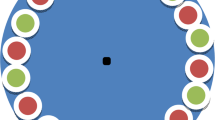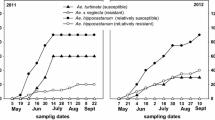Abstract
The extracts, obtained with methanol from crushed trifoliates and from the surface layer of the trifoliates, contained isoflavones in both the free and bound forms as the major components, compounds known to exhibit feeding deterrence towards the redlegged earth mite. The levels of these compounds were quantified and showed considerable variation in extracts of one susceptible variety and four varieties with differing levels of resistance. The relative resistance of the five varieties established from field observations was compared with the amounts of isoflavone derivatives obtained in the two extracts. A better ranking of resistance was found with levels of isoflavones on the leaf surface than with the total amount of isoflavones in the trifoliates. These results suggest a simple method for determining the relative resistance of subterranean clover to the mite.
Similar content being viewed by others
REFERENCES
Barz, W., and Welle, R. 1992. Biosynthesis and metabolism of isoflavones and pterocarpan phytoalexins in chickpea, soyabean and phytopathogenic fungi, pp. 139–164, in H. A. Stafford and R. K. Ibrahim (eds.). Phenolic Metabolites in Plants. Plenum Press, New York.
Beck, A. B. 1964. The oestrogenic isoflavones of subterranean clover. Aust. J. Agric. Res. 15:223–230.
Gillespie, D. J. 1994. Identification and development of annual legume varieties with resistance to the redlegged earth mite, pp. 1–4, in G. McDonald and A. A. Hoffmann (eds.). Redlegged Earth Mite, Lucerne Flea and Blue Oat Mite, Proceedings of the Second National Workshop. Rutherglen, Victoria, Australia.
Hashidoko, Y. 1996. The phytochemistry of Rosa rugosa. Phytochemistry 43:535–549.
Hashidoko, Y., Tahara, S., and Mizutani, J. 1992. Rugosal A and related carotane sesquiterpenes in the glandular trichomes of Rosa rugosa. Phytochemistry 31:779–782.
Jiang, Y., Ghisalberti, E. L., and Ridsdill-Smith, T. J. 1996a. Correlation of 1-octen-3-one with antixenotic resistance in subterranean clover cotyledons to redlegged earth mite, (Halotydeus destructor) Acarina: Penthaleidae). J. Chem. Ecol. 22:369–382.
Jiang, Y., Ridsdill-Smith, T. J., and Ghisalberti, E. L. 1996b. Assays for the effects of volatile compounds from artificially damaged cotyledons of subterranean clover on the redlegged earth mite (Halotydeus destructor). Exp. Appl. Acarol. 20:61–72.
Jiang, Y., Ridsdill-Smith, T. J., and Ghisalberti, E. L. 1997. The effect of volatile metabolites of lipid peroxidation in the aggregation of redlegged earth mites Halotydeus destructor (Acarina: Penthalidae) on damaged cotyledons of subterranean clover. J. Chem. Ecol. 23:163–174.
Lane, G. A., Biggs, D. R., Russell, G. B., Sutherland, O. R. W., Williams, E. M., Maindonald, J. H., and Donnell, D. J. 1985. Isoflavonoid feeding deterrents for Costelytra zealandica. Structural-activity relationship. J. Chem. Ecol. 11:1713–1734.
Ridsdill-Smith, T. J. 1997. Biology and control of Halotydeus destructor Tucker (Acarina: Penthaleidae): A review. Exp. Appl. Acarol. 21:195–224.
Ridsdill-Smith, T. J., and Gillespie, D. 1993. Assays for the study of subclover resistance to redlegged earth mite, pp. 326–329, in S. A. Corey, D. J. Dall, and W. M. Milne (eds.). Pest Control and Sustainable Agriculture. CSIRO, Australia.
Russell, G. B., Sutherland, O. R. W., Lane, G. A., and Biggs, D. R. 1979. Is there a common factor for insect and disease resistance in pasture legumes? pp. 95–97, in T. K. Crosby, and R. P. Pottinger (eds.). Proceeding of the 2nd Australasian Conference on Grassland Invertebrate Ecology. Government Printer, Wellington.
Sutherland, O. R. W., Russell, G., Biggs, D. R., and Lane, G. A. 1980. Insect feeding deterrent activity of phytoalexin isoflavonoids. Biochem. Syst. Ecol. 8:73–75.
Wang, S. F., Ghisalberti, E. L., and Ridsdill-Smith, J. 1998a. Bioactive isoflavanols and other components from Trifolium subterraneum. J. Nat. Prod. 61:518–520.
Wang, S. F., Ridsdill-Smith, J., and Ghisalberti, E. L., 1998b. Role of isoflavonoids in resistance of subterranean clover trifoliates to the redlegged earth mite Halotydeus destructor. J. Chem. Ecol. 24:2089–2100.
Author information
Authors and Affiliations
Rights and permissions
About this article
Cite this article
Wang, S.F., Ridsdill-Smith, T.J. & Ghisalberti, E.L. Levels of Isoflavonoids as Indicators of Resistance of Subterranean Clover Trifoliates to Redlegged Earth Mite Halotydeus destructor . J Chem Ecol 25, 795–803 (1999). https://doi.org/10.1023/A:1020840616583
Issue Date:
DOI: https://doi.org/10.1023/A:1020840616583




